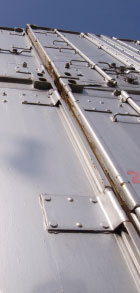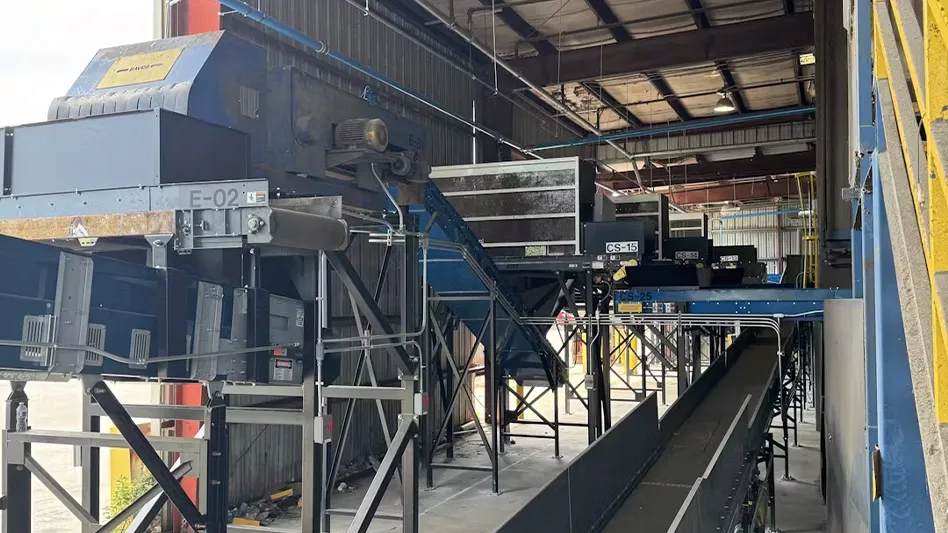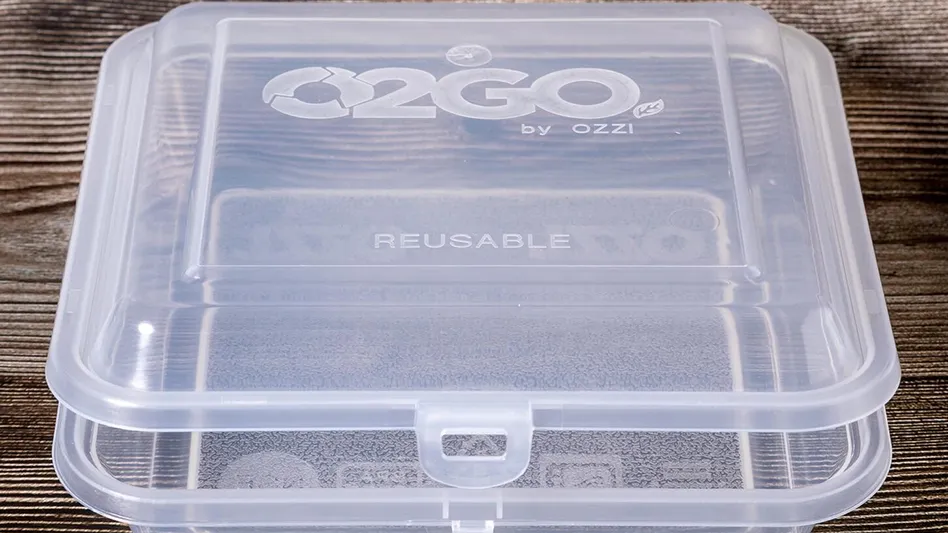 The theft of high-value nonferrous scrap, metals, primarily copper, from intermodal shipping containers is a growing issue for the metals recycling industry.
The theft of high-value nonferrous scrap, metals, primarily copper, from intermodal shipping containers is a growing issue for the metals recycling industry.
The issue gained attention during the first half of 2012, with reports that intermodal shipping containers destined for China were being broken into and a portion of the copper scrap inside being stolen. Once the container was delivered to the buyer, the contents could be short by several hundred pounds or even by several tons, with some sources reporting losses in excess of $50,000 in a shipment.
The seals on the effected containers may or may not have been broken in committing the thefts, further bewildering the parties involved in these transactions.
Rather than because of diligent security, several scrap metal recyclers say the subsequent decline in thefts of scrap metals from containers corresponds with the overall softening in shipments of scrap metals to China.
Despite the recent decline in incidents, recyclers are still concerned. Robert Voss, managing director for Voss International, a U.K.-based scrap metal exporter, touched on the theft of copper from sealed containers at the Bureau of International Recycling (BIR) Autumn Round-Table Sessions in Barcelona in late October 2012. In his presentation, Voss noted that his own firm had been hit by multiple thefts during the second half of 2012. He added that several other nonferrous exporters he had talked to said theft from shipping containers continues to be a significant problem for the industry.
Despite the prevailing opinion that thefts from containers have declined recently, David Chiao with Uni-All Group Ltd., an Atlanta-based exporter of nonferrous scrap, says that in late November thieves stole copper scrap from five out of nine containers that were shipped by an exporter whom he knows. The estimated loss totaled roughly $75,000.
Steve Solomon, president of Solomon Metals, a scrap metal exporter based in Lynn, Mass., says container theft has occurred to some degree during the past 30 years. He says similar thefts took place in South Korea in the 1980s.
Ground Zero
Many exporters say that such thefts have taken place at a number of Asian ports, with ports in Hong Kong and southern China reportedly the biggest areas for trouble.
“The southern China ports, like Sanshui, Sanshan, Huizhou, Huadu, Zhoaqing and Nanhai, etc., are the most affected ports according to our research,” says Muzammil Jaji Amin, president of ALA Group, a metals recycling company headquartered in the United Arab Emirates.
However, theft also has been a problem outside of China. Another scrap metal exporter says a port in Mumbai, India, also has seen its share of thefts from containers.
Amin says Asia is rife with theft because of the shipping system itself, which allows for containers to go out of government jurisdiction during transit.
He adds that while his company ships a range of nonferrous metals to China, only the copper scrap has been stolen.
ALA Group, which has been hit by thieves a number of times throughout 2012, has gone to the scenes of the thefts, investigating ways in which a container can be opened without breaking the seal. (A video shot by ALA Group illustrates how this can be done. It is available at www.RecyclingToday.com/intermodal-container-theft.aspx.)
Amin says a container typically has four handles. Usually, shippers will place the seal in the middle of a handle so that it is broken when the container is open. But, thieves have been known to remove a bolt on the container without breaking the seal.
Blame Game
Bob Stein, chair of the BIR Nonferrous Division and a vice president of Alter Trading, a large scrap metal recycling firm headquartered in St. Louis, says theft is a major issue for the scrap industry. He says he suspects that criminal syndicates are behind much of the theft and that they have inside information on the material inside the containers.
Despite his suspicion about the origin of such thefts, Stein adds, “It is hard to know who is responsible for the theft. Somehow, someone is letting people in on the deal.”
He says that because of the uncertainty regarding the parties responsible for the thefts, “Our suspicions are with everyone.”
Chiao says he believes customs agents, who end up seeing bills of lading showing the containers’ contents, are likely involved.
However, Voss questions the role of inside information. He points out that while containers packed primarily with copper are being targeted, because of the material’s classification, the information is accessible to many people.
The issue had gotten so difficult in 2012 that the Institute of Scrap Recycling Industries Inc. (ISRI), Washington, D.C., had asked the Chinese government for assistance looking into the problem. Although, so far the request has generated little positive news, Stein says.
Several scrap metal recyclers say the best way to solve the problem is to get the Chinese government to address the issue. However, many of these same dealers say the Chinese central government has not come up with a plan to halt the thefts.
Pottengal Mukundan, director of the International Maritime Bureau’s (IMB) ICC Commercial Crime Services division, says that while scrap metal vendors have pointed fingers at employees of the Chinese government, he doesn’t believe they are truly involved in the problem.
“It may be in some cases that some low-level officials also participated in the theft. However, normally when this comes to light, the official bodies in the country will respond,” Mukundan says.
Amin says the Chinese government has yet to acknowledge the problem. “The government doesn’t seem to notice the loopholes and is not really aware of the problem. Also, we don’t see them curbing the thefts at the moment.”
Investigating the Issue
To get a better understanding of how pervasive theft from containers is, the BIR recently contracted with the IMB to study the problem and to offer recyclers recommendations designed to reduce future incidents of theft from shipping containers.
“We also provide the ability for all members of BIR to report losses and cases of fraud involving recyclables,” Mukundan says. “This will be distilled into loss prevention advice for the other members of BIR. The ultimate result of this will be that losses will be reduced.”
|
Fractured Relationships While the theft of nonferrous metals from intermodal shipping containers can cost a company thousands of dollars, they also can strain relationships between the buyer and seller. If the shipping company’s insurance doesn’t cover the cost of the theft, the question turns to which party is responsible for covering the difference in the shipment. One source, who requested anonymity, says this debate can strain relationships between parties, even those with long-standing business relationships. “Oftentimes there is an element of suspicion, especially when the container has an unbroken seal but is light,” he says. Bob Stein, chair of the Bureau of International Recycling Nonferrous Division and a vice president of Alter Trading, a large scrap metal recycling firm headquartered in St. Louis, asks, “What do I do with my customers who are upset about the material missing? I am mad too.” Muzammil Jaji Amin, president of ALA Group, a metals recycling company headquartered in the United Arab Emirates, says, “This issue has caused distrust between the buyer and seller, further resulting in raising the chances of a claim.” Ill will can develop between the supplier and buyer, though neither party is responsible for the theft. |
Mukundan adds that the problem is a growing concern. “We do not have any statistics, but there have been reports of many such containers being targeted by organized crime groups, both in Europe and in East Asia, including China. Typically, the containers are either in a transit location or being transported by truck. The truck is forced to stop, and the containers are opened and their contents transferred to another vehicle. There are well-known methods by which containers can be broken into without disturbing the seal.
“Any time that the containers are trans-shipped from one vessel to the quayside and onto another, there is always a risk that the containers will be interfered with if the container depot/port is not properly monitored,” Mukundan continues. “There is less monitoring in the smaller ports far away from the attention of national authorities.”
While some scrap metal exporters say shipping lines should do more to prevent theft, IMB says they are merely carriers of the containers.
“We are not aware of any cases where global shipping lines have been involved in the thefts,” he says.
It is in the interest of the shipping lines to reduce these thefts, as they likely will become part of the claims chain when the theft is discovered, Mukundan says. “This is particularly so if warehouse-to-warehouse bills of lading are issued,” he adds.
Voss agrees that shipping lines don’t have direct responsibility for the thefts, though he says he wishes they would work with scrap metal recyclers to reduce the possibility for theft.
He adds that some shipping lines have placed tracking devices in containers, but this measure can be expensive.
Getting Covered
A related issue is that oftentimes it is difficult to prove the theft actually took place. And, because many insurance companies have been balking at paying for the losses, the ICC advises shippers to take extra precautions.
“It is important that all these cargoes are properly insured under “Clause A” of the Institute Cargo Clauses,” Mukundan says. “Under these sets of clauses, theft of the cargo is an insured peril. This is not always the case with other levels of insurance. If theft is not an insured peril, then the loss will fall solely upon the owner of the goods.”
He adds that cargo owners who are facing a loss must inform their insurance carriers within the time frame specified in their respective contracts.
“We would also advise that they report these losses to the IMB so that a picture of the losses can be drawn up,” Mukundan says. As the IMB identifies trends, it will report this information to the appropriate law enforcement agencies.
Amin says it may be difficult to obtain insurance for such shipments in the first place in light of the extent of the theft problem. “The insurance companies have stopped insuring containers shipping to South China due to repeated cases of theft,” he says.
Solomon says that while insurance is an option, the premium can be greater than the actual value of the stolen cargo.
Amin adds that the premiums his firm paid were from six to seven times higher than a typical premium. Despite these higher premiums, he says that after multiple thefts the insurance company “gave up.”
Sealing the Deal
Voss suggests that exporters use better seals on their containers. “People have tightened up their seals, which has alleviated some of the problems.”
Because the containers are basically just a box, it is fairly easy to get into them, he says. He equates the container with a package being shipped through the mail. While the contents can be stolen from a box used to ship an item, the more packing tape you put on that box, it will be less likely someone will go to the trouble to open the box to remove its contents. The same applies to the shipping containers, he says. Putting more seals on a container can reduce the chance that it will be broken into, Voss adds.
Amin says shippers also can consider changing the placement of the seal. Instead of putting the seal on the handle of the container, he suggests placing it at the hub bolt at the bottom of the container. By placing the seal on the “cam keeper,” it will be more difficult for the thief to steal cargo from the container without breaking the seal, he says.
Despite these precautions, Voss says that if a thief wants to steal the material, he or she will.
“We might just stop shipping the material to the region,” Stein says. “We can ship the material other places.”
To those recyclers who would like to continue shipping material to the region, the ICC suggests adopting the following measures:
- To the extent possible, keep the contents of the containers, the dates of shipment and route and the identity of the carrier confidential.
- Ensure the shipment follows the most direct route from its origin to its destination. If the cargo has to be transshipped, a risk assessment should be conducted at the points of transshipment to ensure that those transit locations are safe and well-monitored.
- Have independent verification of the contents of the container when they are packed into the container and when the container arrives at the discharge warehouse.
- If possible, install monitoring devices. Any deviation from the route should be immediately reported to the appropriate authorities. A company’s risk assessment exercise should include contact information for these law enforcement agencies as well as their ability to respond to such concerns.
By following this advice, shippers can hope they will avoid the problem of scrap theft from intermodal containers that has been aggravating the nonferrous metals recycling industry.
The author is senior editor of Recycling Today and can be contacted at dsandoval@gie.net.

Explore the January 2013 Issue
Check out more from this issue and find you next story to read.
Latest from Recycling Today
- Novelis quarterly, full-year net sales down; CEO reports ‘strong improvements’
- Meeting the decarbonization challenge
- Cyclic Materials expands leadership team
- Paper cup acceptance at US mills reaches new milestone
- EPA announces $3B to replace lead service lines
- AMCS showcasing Performance Sustainability Suite at WasteExpo
- New Way and Hyzon unveil first hydrogen fuel cell refuse truck
- Origin Materials introduces tethered PET beverage cap





